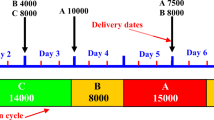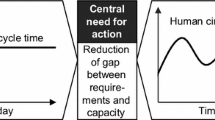Abstract
Controlling the time synchronicity of supply processes for assembly requires a quantitative measure. An existing controlling instrument, the supply diagram, already provides an effective way of assessing the supply situation. It incorporates different key figures which allow for an evaluation of a company’s supply process coordination. However, it lacks a key figure for describing the level of time synchronicity. Therefore, a quantitative evaluation of actions to improve the time synchronicity in supply processes is not possible. Based on an existing approach of approximating the completion of full assembly orders, a key figure for describing the level of time synchronicity is developed in this article: the synchronicity factor. As this new key figure is dependent on the average number of components required for one assembly order for the regarded time period, a second measure, the relative synchronicity factor, accounts for this number and can thereby be used to compare different time periods. As the numerical calculation of the synchronicity factors is a complex problem, the possibility of applying a simple hill climbing algorithm to accurately determine the synchronicity factor for a certain supply situation is examined.





Similar content being viewed by others
References
Pashaei S, Olhager J (2015) Product architecture and supply chain design: a systematic review and research agenda. Supply Chain Manag Int J 20(1):98–112
Sinn HW (2006) The pathological export boom and the bazaar effect: how to solve the German puzzle. World Econ 29(9):1157–1175
Rudberg M, Olhager J (2003) Manufacturing networks and supply chains: an operations strategy perspective. Omega Int J Manag Sci 31(1):29–39
Brennan L, Gupta SM, Taleb KN (1994) Operations planning issues in an assembly/disassembly environment. Int J Oper Prod Manag 14(9):57–67
Nyhuis P, Beck S, Schmidt M (2013) Model-based logistic controlling of converging material flows. CIRP Ann Manuf Technol 62(1):431–434
Domingo R, Alvarez R, Peña MM, Calvo R (2007) Materials flow improvement in a lean assembly line: a case study. Assem Autom 27(2):141–147
Beck S, Schmidt M, Nyhuis P (2011) Controlling the time synchronicity of convergent supply processes. In: Ao SI et al (eds) Proceedings of the World Congress on Engineering and Computer Science, vol 2. Newswood Limited, Hong Kong, pp 1150-1154
Beck S (2013) Modellgestütztes Logistikcontrolling konvergierender Materialflüsse. Dissertation, Leibniz Universität Hannover, PZH, Garbsen
Schmidt M (2011) Modellierung logistischer Prozesse der Montage, Dissertation, Leibniz Universität Hannover, PZH, Garbsen
Giunipero LC, Eltantawy RA (2004) Securing the upstream supply chain: a risk management approach. Int J Phys Distrib Logist Manag 34(9):698–713
Hesse S (2012) Montagegerechte Produktgestaltung. In: Lotter B, Wiendahl H-P (eds) Montage in der industriellen Produktion, 2nd edn. Springer, Berlin
Schuh G, Stich V, Hocken C, Schenk, M (2015) Design of an integrated model for the real-time disturbance management in transportation supply networks. In: Umeda S et al (eds) Advances in production management systems: innovative production management towards sustainable growth, vol 1. Springer, Heidelberg, pp 144-151
Williamson OE (1979) Transaction-cost economics: the governance of contractual relations. J Law Econ 22(2):233–261
Fill C, Visser E (2000) The outsourcing dilemma: a composite approach to the make or buy decision. Manag Decis 38(1):43–50
McCarthy I, Anagnostou A (2004) The impact of outsourcing on the transaction costs and boundaries of manufacturing. Int J Prod Econ 88(1):61–71
McGovern T, Hicks C, Earl CF (1999) Modelling supply chain management processes in engineer-to-order companies. Int J Logist Res Appl 2(2):147–159
Olhager J, Östlund B (1990) An integrated push-pull manufacturing strategy. Eur J Oper Res 45(2):135–142
Lutz S, Lödding H, Wiendahl HP (2003) Logistics-oriented inventory analysis. Int J Prod Econ 85(2):217–231
Prüssing PB, Baumgarten S, Ullmann G (2012) New approaches for analyzing the logistical synchronization of material provision in production networks. Industrial Engineering and Engineering Management (IEEM), Hong Kong
Nickel R (2008) Logistische Modelle für die Montage. Dissertation, Leibniz Universität Hannover, PZH, Garbsen
Beck S, Schmidt M, Nyhuis P (2011) Modeling converging material flows in the supply chain. In: Proceedings of 21st international conference on production research, Stuttgart, Germany
Manitz M, Tempelmeier H (2012) The variance of inter-departure times of the output of an assembly line with finite buffers, converging flow of material, and general service times. OR Spectr 34(1):273–291
Kettner H (1976) Neue Wege der Bestandsanalyse im Fertigungsbereich: Methodik praktische Beispiele EDV-Programmsystem, Arbeitsausschuß Fertigungswirtschaft (AFW) d. Dt. Ges. f. Betriebswirtschaft (DGfB), Hannover
Björck A (1996) Numerical methods for least squares problems. Society for Industrial and Applied Mathematics, Philadelphia
Johnson AW, Jacobson SH (2002) On the convergence of generalized hill climbing algorithms. Discrete Appl Math 119(1):37–57
Acknowledgments
This publication has been composed as part of research project “Network Control Technique for a Synchronous Material Supply for Assembly”, which is founded by the German Research Foundation (DFG). The authors thankfully acknowledge its financial support.
Author information
Authors and Affiliations
Corresponding author
Rights and permissions
About this article
Cite this article
Hund, E.C., Rochow, P., Mach, F. et al. Quantitative controlling approach of time synchronicity in convergent supply processes. Prod. Eng. Res. Devel. 10, 319–327 (2016). https://doi.org/10.1007/s11740-016-0671-x
Received:
Accepted:
Published:
Issue Date:
DOI: https://doi.org/10.1007/s11740-016-0671-x




